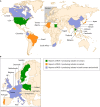Polymyxins: Antibacterial Activity, Susceptibility Testing, and Resistance Mechanisms Encoded by Plasmids or Chromosomes
- PMID: 28275006
- PMCID: PMC5355641
- DOI: 10.1128/CMR.00064-16
Polymyxins: Antibacterial Activity, Susceptibility Testing, and Resistance Mechanisms Encoded by Plasmids or Chromosomes
Abstract
Polymyxins are well-established antibiotics that have recently regained significant interest as a consequence of the increasing incidence of infections due to multidrug-resistant Gram-negative bacteria. Colistin and polymyxin B are being seriously reconsidered as last-resort antibiotics in many areas where multidrug resistance is observed in clinical medicine. In parallel, the heavy use of polymyxins in veterinary medicine is currently being reconsidered due to increased reports of polymyxin-resistant bacteria. Susceptibility testing is challenging with polymyxins, and currently available techniques are presented here. Genotypic and phenotypic methods that provide relevant information for diagnostic laboratories are presented. This review also presents recent works in relation to recently identified mechanisms of polymyxin resistance, including chromosomally encoded resistance traits as well as the recently identified plasmid-encoded polymyxin resistance determinant MCR-1. Epidemiological features summarizing the current knowledge in that field are presented.
Keywords: Gram-negative bacteria; MCR-1; lipopolysaccharide; polymyxins; toxicity.
Copyright © 2017 American Society for Microbiology.
Figures








References
-
- Benedict RG, Langlykke AF. 1947. Antibiotic activity of Bacillus polymyxa. J Bacteriol 54:24. - PubMed
-
- Brink AJ, Richards GA, Colombo G, Bortolotti F, Colombo P, Jehl F. 2014. Multicomponent antibiotic substances produced by fermentation: implications for regulatory authorities, critically ill patients and generics. Int J Antimicrob Agents 43:1–6. doi: 10.1016/j.ijantimicag.2013.06.013. - DOI - PubMed
Publication types
MeSH terms
Substances
LinkOut - more resources
Full Text Sources
Other Literature Sources
Molecular Biology Databases

